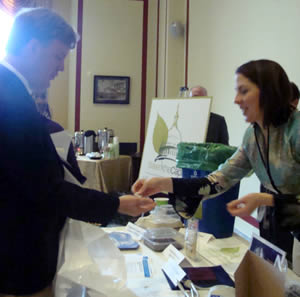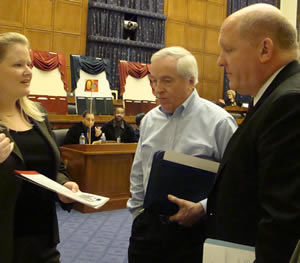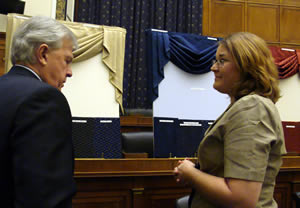Congress Transitions:
How CAO Employees Make Members Feel at Home in the House

A new Member greets Faye Cobb, the Deputy Director of Financial Counseling.
The Transition to a new Congress ushers in a slew of faces, bright and ready to take on challenges. The people who make sure they arrive smiling and stay that way may be in softer focus, but they are nonetheless committed to supporting the lower chambers newest members.
“What we want to do is to make sure all the things in a new Members office are in place, so that they can hit the ground running,” Transition Liaison Helene Flanagan said.
The Transition to the 111th Congress is a major undertaking by any estimation. Fifty four new Members will go through orientation and be moved into their new offices. Their arrival and the departure of other Members will lead to 237 moves, which must be completed in just over a month.
“None of this happens in a void. It requires months of planning, massive coordination of nearly every CAO department and the cooperation of hundreds of dedicated employees,” Chief Administrative Officer Dan Beard said. “But the mission is the same — to ensure our customers, the Members, are taken care of so they can best support their constituents.”

A new Member fills out his contact information and prepares to get a pager for a meeting with an architect.
Flanagan estimates that 500 CAO employees are involved in some aspect of the Transition, the planning of which began in January.
The recent New Member Orientation offers a glimpse into the dedication that each Transition demands.
The event called for the CAO to coordinate with the Committee on House Administration and the Architect of the Capitol.
The orientation showcased an array of CAO departments and services available to new members, including: upholstery and carpet, BCDR emergency preparedness, Payroll and Benefits, the Office Supply Store and the Green the Capitol program.
“We’re killing a lot of birds with one stone and trying to make [Members’] experiences stress free and enjoyable,” Flanagan said.

the Capitol program director Allison Rogers gives a new Member a Green the Capitol magnet.
At the event, Members also participated in a lively lottery to choose their rooms, proof that moving in can be a lot of fun.
“It’s like Christmas morning for new Members. They’re just so excited to be there and it’s great to be a part of that.” Tina Hanonu, Director of HIR Technology Support, said.
New Members were also introduced to the House’s eco-friendly Green the Capitol Initiative. The carpet and drapes they chose were made using sustainable materials in an environmentally-friendly process. The light bulbs in their offices will be eco-friendly compact fluorescent lights bulbs (CFLs) and their water coolers will be energy efficient.
“We know it’s really important to make greening as automatic and as easy for them as possible,” Flanagan said.
The Transition Website features an application called Picture Your Move, which shows Members how they can green their new offices with compost bins, energy efficient equipment and eco-friendly carpeting, among other things.

Business Continuity Manager Megan educates a Member on the Houseís BCDR emergency preparedness program.
“By greening the Transition process and educating new Members along the way, they will know that greening is a priority in the House,” said Robert Lane, Director of the Green the Capitol program.
The process of readying offices for Members has been refined consistently over the years, so that on Dec. 1 months of planning ensures a quick, seamless move.
“It’s like a play. Everyone knows when they’re going onstage,” Flanagan, who has worked through eight Transitions, said.
The CAO and the AOC work together to move 10 offices every day, six days a week, with the average move taking four hours to complete.
Employees volunteer to put their “day jobs” on hiatus and become Move Coordinators during the transition.

Carol Swan, manager of the AFLís drape and upholstery division, consults with a new Member.
The work that goes into Transition doesn’t begin when the furniture gets moved or even end when a Member moves in. On the contrary, it begins months before and lasts for months after they arrive.
The Office of Employee Assistance coordinates departing Member services including career planning, resume writing and interview skills.
“We help people transition out of the House in a healthy way and help them find the next leg of their journey,” Senior Employee and Organization Consultant Liz McBride-Chambers said.
HIR assists departing Members in storing data and uninstalling their computers. They also install computers for new Members and teach them how to use their Blackberries. In an effort to be more environmentally-friendly, HIR is also putting many of its orientation materials online for the first time. The department also sets up hundreds of network connections and IP addresses during Transition.
HIR telecommunications manager Marion Pacic, who has worked on the Transition since the 104th Congress, said the CAO “evolved.”
“When I started there were no PCs or Blackberrys, so there was no technology to give them,” she said. Now we not only have technology, but we’re greening our technology.”
The CAO’s work continues long after the Members move in. Specialists from all across the organization continue to reach out to Members to ensure they are properly settled into both their D.C. and District Offices.
It’s all worth it, Pacic said. “If you do it right it gives you a sense that you really helped.”
Flanagan agreed.
“They’re making history and we’re a part of that, so it’s pretty cool.” she said.